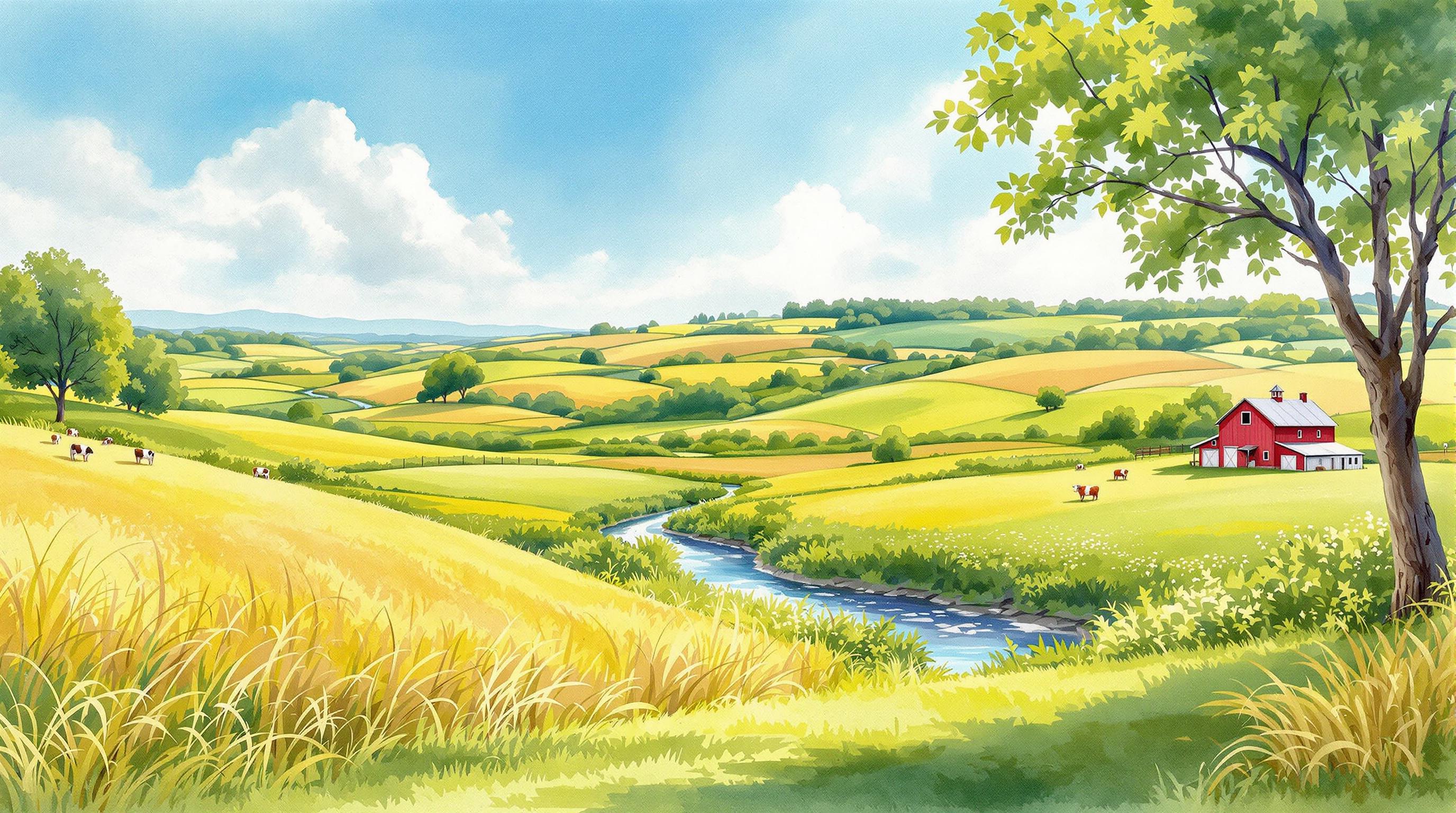Lancaster County offers diverse hunting opportunities with 68% farmland, supporting game like deer, turkey, and waterfowl. In 2024, 700 new public hunting acres were added through conservation efforts. Key factors for buyers include:
- Zoning Rules: Hunting land falls under Agricultural (AG) or Agricultural Residential (AGR) zones, with safety setbacks (e.g., 50-150 yards).
- Property Size: Ideal ranges are 50-100 acres for most game. Turkey thrives on 100-150 acres.
- Land Features: Look for mixed habitats (nut forests, food plots, water sources).
- Costs: Land prices vary between $5,000-$20,000 per acre, with tax benefits from the Clean and Green program offering up to 50% savings.
For public hunting, Lancaster has 3 county parks, while Berks County offers 45,000+ acres of State Game Lands. Buyers should evaluate zoning, habitat quality, and financing options when selecting land.
Buying Hunting Land? How Much Ground Do You Really Need?
Local Zoning Laws and Rules
Lancaster County's zoning rules are key to determining how hunting land can be used. Properties suitable for hunting are typically categorized into two main zones: Agricultural (AG) and Agricultural Residential (AGR). These zones influence safety measures like setback distances, as noted earlier.
Property Zones and Limits
The Agricultural (AG) zone is designed to support and protect farming activities in appropriate areas. This zoning often allows more freedom for hunting on larger plots of land. Here's a quick breakdown:
| Zone Type | Purpose | Permitted Uses | Additional Notes |
|---|---|---|---|
| Agricultural (AG) | Preserve farming | Hunting, farming, conservation | Partnerships with conservation groups [4] |
| Agricultural Residential (AGR) | Mixed-use | Hunting with residential considerations |
The size of the property also matters. For instance, owners of 50 or more contiguous acres in AG/AGR zones can get early license access. Properties with 80+ acres that are part of conservation plans may qualify for $3 resident licenses through public access programs [6].
Required Land Size and Setbacks
Safety setbacks are strictly enforced in agricultural zones. For example, East Cocalico Township requires the following minimum setbacks for agricultural properties:
- Front yard: 50 feet
- One side: 25 feet
- Combined sides: 50 feet
- Rear yard: 50 feet [7]
Additionally, tree stands must include owner identification and must be removed after the hunting season, as per Game Commission regulations [4].
Selecting the Right Property Size
Once you've confirmed zoning compliance, the next step is choosing the right acreage. Here's what to keep in mind:
When looking at hunting land in Lancaster County, the size of the property should match your target game species and management goals. For most hunters, 50-100 acres strikes a good balance between wildlife habitat and hunting potential [2]. Smaller properties can work too, especially with careful management. For example, wild turkey populations typically need 100-150 acres to thrive.
Land Features for Wildlife
Lancaster County offers diverse landscapes, so aim for properties that include a mix of features like mature nut forests, young bedding areas, food plots, and water sources [4]. According to the Pennsylvania Game Commission, properties with a variety of habitats tend to support healthier wildlife populations [4].
Property Access and Utilities
Look for land with maintained roads, clearly marked boundaries, and existing trails. Reliable cell coverage is also important for safety, especially in remote areas.
Costs and Tax Benefits
Land prices in the area range from $5,000 to $20,000 per acre [9], with premium habitats costing more. Lancaster County's Clean and Green program can help lower costs significantly. This program offers tax reductions of 50% or more for qualifying agricultural or forest land [3].
Here are a few ways to make ownership more affordable:
- Manage timber sustainably
- Lease the land for agriculture
- Offer seasonal hunting leases
- Enroll in conservation programs
sbb-itb-7fa5722
Lancaster County Land Options
Lancaster County provides creative ways to meet hunting needs while preserving land. These initiatives blend conservation efforts with thoughtful planning, offering opportunities for hunters and property owners alike.
Partnering with Conservation Groups
In addition to the Clean and Green tax benefits mentioned earlier, local conservation programs expand access to hunting lands. The Lancaster Conservancy, for example, manages over 6,000 acres across 34 nature preserves[4]. In 2024, they plan to add nearly 700 acres through seven new preserves in Lancaster and York counties[5].
Landowners can get involved through:
- Habitat Improvement Partnerships: Programs that encourage wildlife management practices to improve habitat quality and hunting opportunities.
Mixed-Use Land Planning
Combining hunting with other land uses can provide additional income while keeping the land suitable for hunting. These strategies build on earlier income models and ensure the land remains functional for various purposes.
| Use Type | Key Features |
|---|---|
| Agritourism | Income from farm-based tourism |
| Sustainable Forestry | Balancing timber production with habitat preservation |
| Farm Integration | Combining crops with food plots |
Preserved lands also qualify for tax benefits, which are determined by factors like soil quality (40%), development potential (12.5%), and site assessments (47.5%)[11]. These scores directly affect eligibility for the Clean and Green program's tax reductions.
Regional Property Comparison
Understanding how regions differ is crucial for buyers considering Lancaster County as a hunting land destination. Lancaster County stands out in many ways when compared to nearby areas, offering unique opportunities for property investment.
County Comparison Data
Lancaster County has 10 hunting properties on the market, with an average listing price of $826,440 and an average cost of $10,698 per acre[13]. These figures highlight the area's emphasis on agricultural land and its central location in Pennsylvania.
| County | Public Hunting Areas | Minimum Acreage Requirements | Average Cost/Acre |
|---|---|---|---|
| Lancaster | 3 county parks[9] | 50 acres (agricultural zones)[12] | $10,698[13] |
| Berks | 45,000+ acres[2] | 10 acres | – |
| Chester | Limited | 10 acres[8] | – |
| York | Varied | Case-by-case[1] | – |
Lancaster County allows hunting in three county parks, while Berks County provides access to over 45,000 acres of State Game Lands. This makes Berks a prime option for hunters relying on public hunting areas.
The hunting experience also varies by habitat. Lancaster County's agricultural fields are ideal for deer and small game hunting, while Berks County's dense forests attract hunters seeking species like bear and turkey[2].
Additionally, property taxes differ across counties. Lancaster's conservation programs play a role in preserving land value and supporting habitat protection efforts.
Getting Started
Now that you've explored regional comparisons, here’s how to take actionable steps toward securing hunting land that meets compliance requirements.
Initial Assessment and Planning
Start by determining your budget and the amount of land you need. Check zoning maps to identify AG/AGR zones, and think about how the land’s features support wildlife habitats.
Professional Guidance
Teaming up with knowledgeable professionals can simplify your search. Central PA Realty, for example, focuses on rural properties in Lancaster County and offers expertise in areas like:
- Evaluating properties for wildlife habitats
- Ensuring compliance with local zoning laws
- Exploring conservation easement options
- Planning for mixed-use purposes
Documentation and Compliance
Once you’ve identified properties of interest, make sure to gather essential documents, such as:
- Property survey records [1]
Financial Considerations
Here are some financing options to consider:
| Option | Key Benefits | Best For |
|---|---|---|
| Conventional Mortgages | Standard terms | Typical property purchases |
| USDA Rural Development | Lower rates | Eligible rural properties |
| Farm Credit Services | Tailored terms | Agricultural or recreational use |
| Owner Financing | Flexible agreements | Direct deals with sellers |
Property Evaluation Checklist
Use this checklist to assess potential properties:
- Quality of habitat (availability of food and water sources)
- Road access and boundary lines
- Neighboring land usage
- Verified water rights
Before making an offer, confirm property boundaries and check for any easements. For additional guidance, the Lancaster County Conservation District can provide information on conservation programs [4].
Central PA Realty also offers free consultations and can connect you with local agents who specialize in rural property transactions.
FAQs
How much does an acre of hunting land cost?
When budgeting for hunting land, prices can vary widely. Current listings show costs ranging from $5,000 to $20,000 per acre [9]. Larger parcels, especially those over 100 acres, tend to be priced lower, often falling below $8,000 per acre [10]. In Lancaster, prices exceed Pennsylvania's average of $4,116 per acre [6], but the area's preserved landscapes add extra appeal.
Here's a breakdown of recent price trends:
| Parcel Size | Price Range |
|---|---|
| Less than 50 acres | $15,000+/acre |
| 100+ acres | Around $8,000/acre |
Larger parcels generally offer a lower cost per acre, but zoning regulations should be carefully reviewed. Additionally, keep in mind that minimum acreage requirements can influence both the price and the practicality of the land for hunting purposes.



